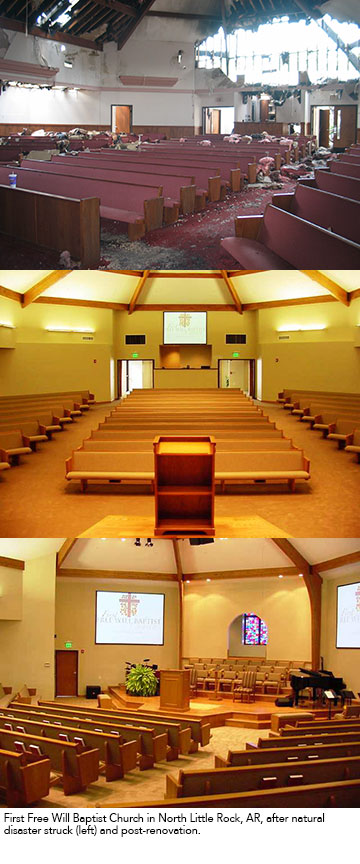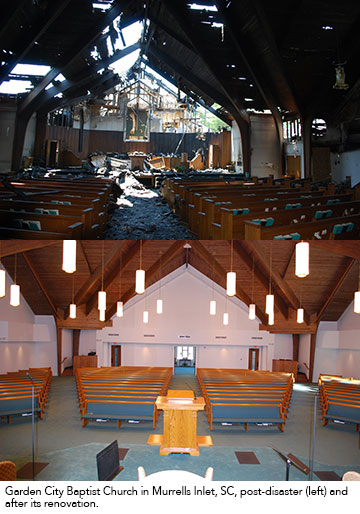When tragedy strikes in the form of a fire, a flood or another natural disaster, a church leader is are forced to make decisions on the fly — often with little knowledge of the potential consequences. Let’s change that.
By Eric Johnson
If a pipe were to break on Saturday afternoon, and it flooded the church sanctuary, would you know who to call?
 Stored in your phone, do you have the emergency phone numbers (and cell phone numbers) for your local restoration contractor? Could you contact that contractor on a Saturday night and ensure its crew would work all night so your church services could proceed on Sunday morning?
Stored in your phone, do you have the emergency phone numbers (and cell phone numbers) for your local restoration contractor? Could you contact that contractor on a Saturday night and ensure its crew would work all night so your church services could proceed on Sunday morning?
If not, it’s a good idea to do some research, now. Get to know the people and resources you’d need in such an event. Let them help you be prepared for a disaster … just in case.
Stressful for the entire congregation
The loss of a church building is a shock to the entire congregation. Most major life events happen within the church, so members experience a personal loss. And, lifelong members have not only personal memories of, but a financial investment in, the building structure.
Losing it is, therefore, very emotional. A grieving process is involved. It’s during this time when communication from church leadership is most important. Pastoral staff needs to be ministering to the congregation full-time, not getting tied up in major decisions about the building or its contents. It’s critical that church members feel communication goes both ways. They need to be heard, as well as informed about what’s going on.
Opportunists and “fire chasers” are common distractions following such disasters. They converge quickly, distracting church leaders’ attention. Each tries to get a piece of the action — and the church’s insurance money.
With all these factors combined, it can be a very stressful time for the church leadership. That’s why it’s important to hire experts; yet, it can be very hard to hire the right experts when all a pastor has is each one’s “story,” and some fancy brochures, to go on.
OK, it happened. Now what?
When GuideOne Taylor Ball is called on-site following a disaster, it’s typically within a day or two. Often, there’s considerable chaos. After a quick review of the damage, we try to set up a meeting with the church leadership and agree on a priority list — what’s important now, and what can be dealt with later. We prefer that the insurance adjuster be part of that meeting to go over policy coverage issues, procedures for reimbursement and so on.
Although every disaster is different, there’s a procedure our team tries to follow whenever we’re called in.
First, we make sure the site is secure. We need to ascertain that no further damage is occurring. Safety is a big concern, and there may be unsafe conditions within the building.
Second, we figure out where to host worship services. Our next question for church leaders is, “Where are we going to have worship services on Sunday?” We ascertain what can be done with the remaining facilities to ensure some semblance of normal operations. (For example, if the sanctuary is destroyed, can the fellowship hall be cleaned up and set up for a church service?)
Third, we zero in on any valuable contents that need to be rescued. In the aftermath of a flood, we’re concerned about mold. To this end, important books and fabrics need to be removed and dried promptly, as mold will quickly destroy them. A flood brings in all sorts of contaminates, so this isn’t a job for amateurs.
After a fire, smoke and soot deposits acids on ornamental metals and glass. Over time, these acids etch and destroy these precious elements, so it’s important to get those items properly and professionally cleaned as soon as possible. Additionally, electronics shouldn’t be started until they’ve been taken apart and cleaned by a professional.
Fourth, we do a hazardous-materials assessment. Before anyone does any major cleanup, our team needs to know if any hazardous materials are present — asbestos or lead, in particular. (Both are very common in older churches.) Typically, we ask an environmental expert to take samples of suspect materials and provide us with a verbal and written report.
Next, we identify and rectify any structural issues. If there appear to be any structural issues that represent safety hazards, or that need to be addressed as part of the rebuild, our team brings in a forensic structural engineer to evaluate and give us a safety report for safety. This is important to have on hand for insurance records, and to provide a design for the repair.
Documenting the damage
 As consultants, one of our major jobs is to document the damage and prepare a restoration plan. Since our specialty is the repair of the building structure, we usually coordinate contents-handling with a local restoration contractor — one selected by the church, the insurance company or by us. Contents must be removed before work can start on the building itself.
As consultants, one of our major jobs is to document the damage and prepare a restoration plan. Since our specialty is the repair of the building structure, we usually coordinate contents-handling with a local restoration contractor — one selected by the church, the insurance company or by us. Contents must be removed before work can start on the building itself.
Then, we begin a detailed study of every room in the building. Our goal is to answer three questions:
1) What’s damaged?, 2) What needs to be done to repair it?, and 3) What will it cost?
We measure each room — including walls, offsets, doors, windows, cabinetry, countertops and shelving. We study every detail of the room in a consistent order: floors, baseboards, walls, ceiling, doors, windows, cabinets, countertop, shelves, trim and any other accessories, respectively. Then, we study the mechanical, plumbing and HVAC, followed by electrical components. We repeat this process for every room in the building which sustained damage.
For each, we document what was in it, and what needs to be done to restore it to its pre-disaster condition. It might be as simple as cleaning; or, it might involve removal-and-reinstall, seal-and-paint or complete replacement. Based on our notes, the team prepares a scope of loss that details what needs to be done to repair the building structure.
Insurance doesn’t guarantee a brand-new church
As soon as the scope of loss is complete, our team’s estimators start a detailed cost estimate. Procedures vary for each insurance company, and laws vary from state to state. Usually, however, a check is written for the depreciated amount of the cost estimate after the estimate is submitted. This is called “actual cash value.”
A second check is written after the church has repaired or replaced the building. This amount is based on the actual cost incurred, or “replacement cost value,” up to the amount ensured by the insurance policy.
It’s important to keep in mind that the cost estimate presented to you by the insurance company is just that: an estimate. It’s not necessarily the final repair cost. Actual repair cost is determined by several factors. For example, items will be discovered and clarified during demolition in areas that aren’t currently visible. These will be factored into the extent of cleaning required through the rebuild process.
For each project we handle, our team attempts to get three bids on every specialty trade. Doing so at the trade level ensures the most competitive pricing. The price of the lowest qualified bidder in each trade determines the actual repair cost.
So, as you can see, this process is a lot more detailed and extensive than simply providing an estimate from a contractor — one which might or might not do the actual repair work for your church in the future.
For these reasons, we recommend bringing a disaster recovery expert on board as a part of your team sooner rather than later. Doing so begins the process of securing actual bid costs that will solidify your position for the ultimate rebuild of your facility, as well as the final claim settlement on your policy.
Don’t wait; plan now
A disaster can be a very stressful event for a church congregation. Being prepared is one of the most important things a church leader can do, today, to eliminate most of that stress and keep the church on the right path to a quick, full recovery.
Eric Johnson is vice president at GuideOne Taylor Ball Construction Services based in West Des Moines, Iowa. As a construction expert specializing in insurance restoration of damaged churches, he has spent the past 14 years helping churches recover from disaster.


